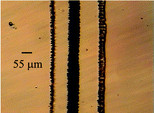One of the limitations of lab-on-a-chip technology has been the lack of integrated power supplies for powering various devices on the chip. This research focused on design of a stackable, microchip-based biofuel cell. The biofuel cell is powered by the addition of ethanol through a flow channel to a bioanode. The bioanode contains a micromolded carbon ink anode that has been modified with two layers. The first layer is poly(methylene green), which is an electrocatalyst for NADH oxidation; the second layer is a membrane that contains an immobilized enzyme, alcohol dehydrogenase. Each layer was characterized electrochemically. It was found that the poly(methylene green) layer is kinetically-limited, but when the complete bioanode is formed, the bioanode is diffusion-limited due to slow mass transport of NADH within the modified Nafion membrane. When used relative to an external platinum cathode, the biofuel cell showed maximum open circuit potentials of 0.34 V and maximum current densities of 53.0 ± 9.1 µA cm−2. This research demonstrates the feasibility of a microfabricated biofuel cell device.

You have access to this article
 Please wait while we load your content...
Something went wrong. Try again?
Please wait while we load your content...
Something went wrong. Try again?


 Please wait while we load your content...
Please wait while we load your content...